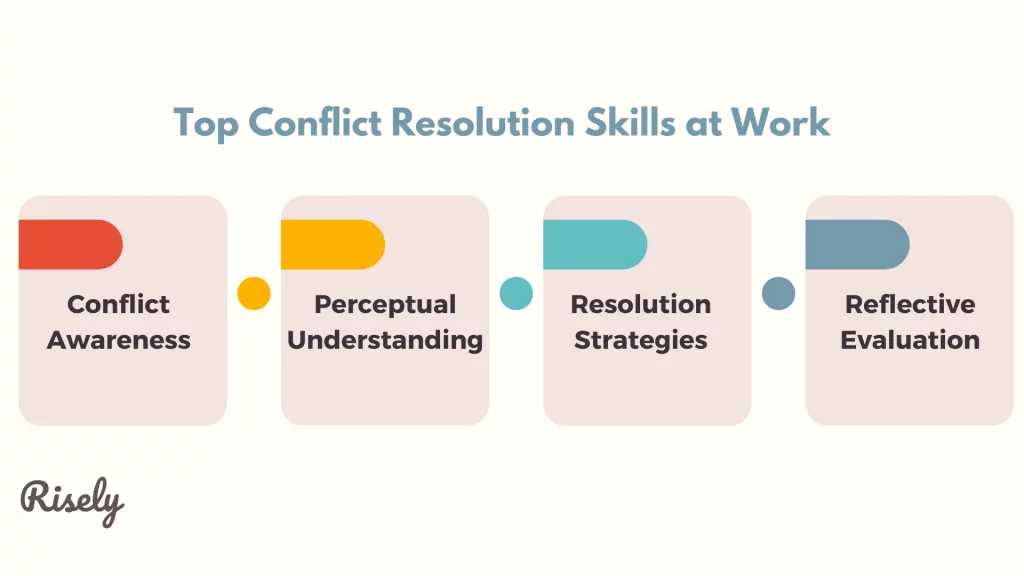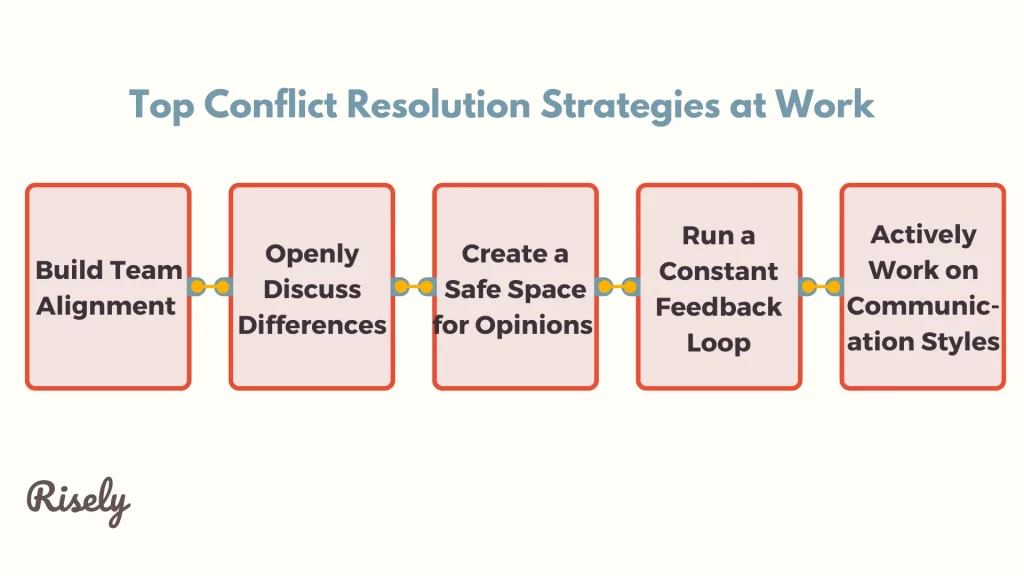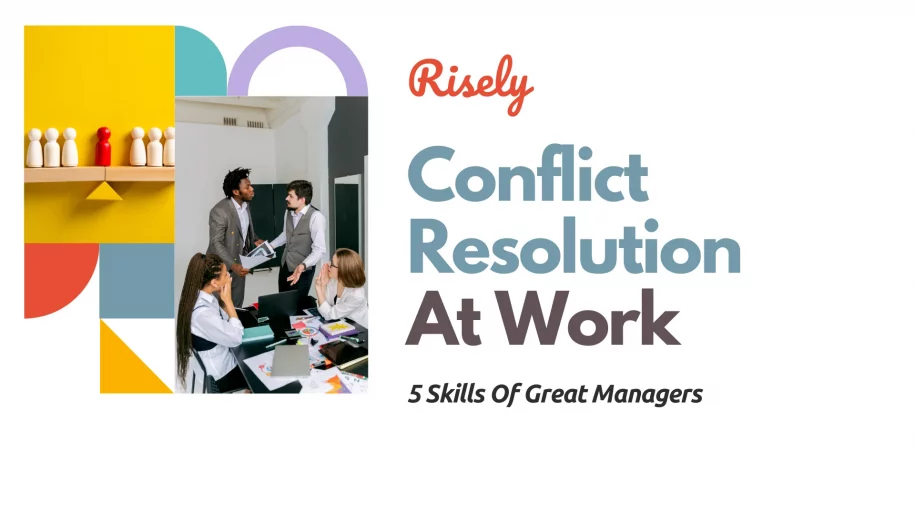5 Secrets To Conflict Resolution At Work For Managers
Conflict is all too common. We often encounter this ever-present demon in our workplaces, too. The trouble is manifold for managers because escape is no longer safe. While you may avoid conflicts personally, they can still arise in your team and become your mess to solve. Running away is not going to be a great solution. So, what can we do? Read on to learn all about conflict resolution at work and find the secrets to effectively build team cohesion and resilience in the face of challenges. Let’s hop right on!What is a Conflict?
Conflict is a disagreement or conflictual situation. It can be personal or professional, arising from varying attitudes, opinions, or ways. When conflict arises in the workplace, it can cause tension and disruption among employees. As a result, set workflows get hampered, and teams often find an uneasy air at work.Why do workplace conflicts arise?
There are no one-shot reasons as to why conflicts at work arise. More often than not, the cause lies in differences, differences in styles of working or communication that can pave the way for two people to get at loggerheads with each other. For instance, a creative difference can divide two team members. While one may want to adopt the brand’s traditional color palette, another may suggest a modern reinterpretation—putting the manager in a fix! Similarly, conflicts can arise due to differences in personality, objectives, or work style. Primarily, the major types of workplace conflicts are:- Leadership conflicts typically involve disputes about the leader’s authority, decision-making power, or strategy.
- Work Style conflicts generally arise from cultural differences, personality clashes, and other views about the job
- Creative conflicts happen when different team members have additional ideas or goals.
- Personality conflicts occurs when two or more people have different personalities, which leads to differences in communication styles and work preferences.
- Task-Based conflicts can arise from various sources, such as different expectations or goals, conflicting work schedules, and insufficient communication.
Is there a good side to conflicts too?
Conflicts generally carry a negative connotation, wherein differences are seen as causes of disputes that limit productivity and push for stagnancy. While this is usually true, conflicts can provide teams with that much-needed impetus to grow. In addition, some conflicts can force managers to rethink their strategies and adopt more innovative methods. Discovering and resolving a row creates a platform for team members and managers to engage openly. As such, some conflicts can be healthy, too!What is Conflict Resolution in the Workplace?
Conflict resolution is a process that helps resolve disagreements between individuals or groups and leads to mutually agreeable solutions. In workplaces, conflict resolution skills are often needed to overcome contesting views and opinions that can cause strife. For managers, conflict resolution at work is the set of techniques that help end conflicts in teams and bring in team cohesion.Why is conflict resolution important in the workplace?
Conflict resolution at work is essential because it helps ensure that all employees know and respect boundaries. It is vital because managers should resolve conflicts within teams fairly and peacefully. A manager has to aim for a mutually beneficial solution instead of a biased adjudication that favors either side. Otherwise, your team might lose confidence in you as an effective manager, paving the way for further distrust. With the help of effective conflict resolution, you can bring together your team in the face of challenging situations, even when team members do not see eye to eye. Without effective conflict resolution at work, you might do a lot of firefighting, constantly caught in a tug-of-war between many parties. Conflict resolution in the workplace frees you from these internal matters and allows you to focus on pertinent issues relating to the strategy and growth of the team. It enables the manager to grow with a team with the help of efficient plans and a resilient team. Read more about the importance of conflict resolution in the workplace here.What are The Top Conflict Resolution Skills at Work?

Conflict Awareness
Before jumping into the arena and solving everything like a boss, step back and see the bigger picture. Try to answer a couple of relevant questions:- What is the root cause of the conflict?
- What is the impact of the conflict?
Perceptual Understanding
Next, examine the parties involved in the conflict. How you communicate and resolve the dispute will depend on who you are dealing with and their objectives. Thus, understand how your team members perceive the conflict. What looks like a simple miscommunication to you could appear to be a planned lack of information to someone else. Moreover, understand their conflict resolution habits to ensure that you can accommodate their needs.Resolution Strategies
It goes without saying, know your stuff before getting into the field. Build a plan on how you want to deal with the conflict and ensure that you have clarity on your ultimate objective. In toto, don’t let problems fester until they become big troubles; take a proactive approach to conflict resolution at work. Also, there are multiple types of conflict resolution styles that managers adopt at work, such as:- Competing, where you fight for what’s yours
- Accommodating, where you are open to understanding the needs of the other side
- Avoiding, AKA withdrawing from the conflict
- Collaborating, which enables you to work together and find a mutually agreeable solution
- Compromising, i.e., letting things be in favor of the other side
Reflective Evaluation
Once you are through, always take time to rethink and reflect on your conflict resolution strategies at work. Sometimes, new ideas or learnings emerge when we look back at the situation. Otherwise, you can also assess yourself using Risely’s conflict resolution skill assessment to prepare for next time. Read about conflict resolution skills in detail here: 10 Skills for Conflict Resolution in Teams and How to Build them?Other Interesting Reads
Top 5 Conflict Resolution Strategies for Workplaces

Build Team Alignment
One of the significant causes of conflict is misalignment across the team. Suppose your team is unsure of where they are collectively moving, and it’s likely they have a hard time figuring out how to move forward. Hence, one of the critical steps in resolving conflicts at work is building alignment. There are a few things that managers can do to align teams and prevent conflicts:- Share information with your team in the right amount and at the right time: If only some of your team members have the inside “scoop,” it’s bound to create resentment and confusion among the rest. Thus, as a manager, ensure that you serve as a reliable source of information for your team and prevent the propagation of misinformation.
- Demonstrate where your team’s efforts fit in: Misalignment can happen when a team is unsure of the vision and mission that is guiding them. When people stab at a problem with different objectives in their head, they are likely to go in other ways only. You can prevent this by setting up shared and interdependent goals and creating a leadership vision to guide your team.
Openly Discuss Differences With Your Team Members
People are different, and that’s a fact we can’t change. But instead of being sad or wary about it, we can embrace and celebrate the differences and make the most of them. Discussing differences among common attributes such as working and communication styles, personalities, or opinions in team meetings and one-on-one chats can help you create a more tolerable and safer space.- Facilitate discussions among your team members: Suppose two of your team members differ in their approach to a problem; what’s the best way out? Give them space to present to their sides and enable them to find common ground. Remember that conflicts are not necessarily a zero-sum game. You can turn them into significant instances of bringing insights and rethinking conventional work approaches.
- Don’t impose your viewpoints: If you direct your team to work in your way, no questions asked, you’d be failing to keep up with the spirit of openness. Whenever conflict strikes, and you need to overcome differences, allow all sides to share their ideas and explain why something is to be followed or not. This includes ideas from seniors because irrational imposition furthers resentment and makes employees feel purposeless.
Create a Safe Space for Opinions
Imagine you have a team that never disagrees or shares contrary opinions. What could be the reason? When team members feel that their views are likely to be discarded or ridiculed, they are unlikely to share ideas. As a result, tempers fester. Otherwise, when these opinions emerge in the heat of the moment, it creates an even bigger problem! Your team needs a safe space to express discontentment or disagreement. Here’s how a manager can build a safe space to minimize conflict in their team:- Establish the ground rules for communication in meetings: Sometimes, your team members might be unable to talk openly because they fear ridicule. As a manager, you can set the ground rules that allow everyone to share ideas quickly. It is constructive for new team members and those from marginalized backgrounds, including women.
- Encourage ideas and questions: As a manager, you can set the ideal tone of meetings by adopting it yourself. This way, many more team members can understand how to raise queries and share their thoughts without conflict. Simple words of appreciation or encouragement can also go a long way.
- Confront the problems: If some of your team members feel uncomfortable, confront the challenges and build psychological safety. The issue could be a senior team member’s intimidating presence or interpersonal conflict finding a home at work among two people—whatever it is, acknowledge and work on it. Throwing it under the carpet is akin to setting up a time bomb for your team.
Run a Constant Feedback Loop for Solid Conflict Resolution at Work
Suppose your manager never asked you how it’s going. You’d hate them, won’t you? So why make the same mistake with your team? Regular feedback loops allow team members to address issues as they arise rather than letting them escalate into conflicts. Feedback helps identify areas for improvement and maintain alignment, thus reinforcing our first step in preventing workplace conflicts. Apart from regular feedback meetings, there can be some more innovative ways to make this exercise pretty impactful for your team:- Conduct peer review sessions focusing on constructive criticism: While doing this, emphasize the use and meaning of constructive criticism as a tool for guiding improvement. It helps address queries that seem inane to you but matter a lot to your team, such as “Alex sits free the whole day,” which can be pretty bitter conflicts once activated.
- Plan your feedback sessions: Give actionable tips and clearly point out areas of improvement for your team members to work toward. By addressing concerns that are valuable to the entire team’s agenda through such mechanisms, you can save yourself a lot of trouble.
Actively Work on Communication Styles
Lastly, take the time to improve and align your team’s communication habits. While some broad differences cannot be removed, you can set up shared spaces and processes to streamline communication. It is important because mismanaged communication, like lack of information or sharing things later, can have bigger ramifications than missed deadlines.- Be open to training: Communication can be a hard nut to crack. It’s about speaking the right words and extends into nonverbal and written aspects. Thus, be open to training or coaching to upgrade your communication skills consistently. Your team can participate in workshops and seminars together, too. If that seems too much, start with a simple and small step: a free assessment of your communication skills by Risely here.
In Conclusion
To wrap up, conflict resolution strategies at work can vary and depend heavily on the manager’s and their team’s context. Yet, we can build some central skills to ensure that we do not approach conflicts in a haphazard fashion and instead take up things logically. Conflict resolution at work remains an important area for managers to master as it is vital in ensuring team cohesion and preventing high turnover rates.Review your conflict resolution skills for free.
Conflicts are troublesome. But you can get through them all with the right skillset. Are you prepared? Find out here.
Other Related Blogs
How to Set Effective Learning and Development Goals?
This blog highlights how effective learning and development goals are set, why is setting them important for your organization and what challenges you might face during this process. … Read…
Are you on track to meet your Q1 goals?
Are you on track to meet your Q1 goals? We are in the middle of the first quarter of 2024. Seems hard to believe. It surely is! ⏰ Time has…
5 Secrets Of Solid Goal Setting At Work You Can’t Miss
5 Secrets Of Solid Goal Setting At Work You Can’t Miss “I don’t focus on what I’m up against. I focus on my goals and I try to ignore the…
Understanding the world of Goal Setting Coach to reach new heights
Understanding the world of Goal Setting Coach to reach new heights Setting and achieving goals is essential for personal and organizational success in today’s fast-paced and competitive work environment. However,…


